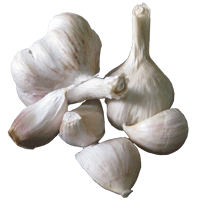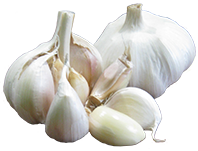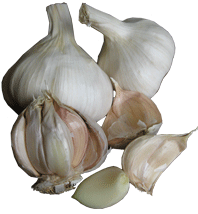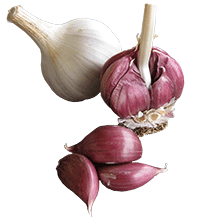| Organic Seeds | Edible Plants | Organic Pest Controls | Books | Tools, Propagation & Fertilisers | Sprouting & Microgreens | Poultry Supplies | Specials & Gift Ideas |

Top

We will send an email to this address*
when is next available
* we will use this email address only for this notification and then we will delete it.
 Home
Home
Green Harvest Organic Gardening Supplies is permanently closed as of 5pm on 1-11-2023.
We will not be taking orders by this website, in person, by phone or email. Our display garden and retail shop are closed forever.
Read more...
Phone:07 54357000
Phone calls will only be responded to sporadically and only in reference to orders placed prior to 2-11-2023. All the useful growing and organic pest management research and resources are available on this website for a while still.
 AVAILABLE FOR PURCHASE:
buy or get emailed when available
AVAILABLE FOR PURCHASE:
buy or get emailed when availableGARLIC GROWING INFORMATION © Frances Michaels
BOTANICAL NAME: Allium sativum
COMMON NAMES: krathiem; bawang putih; bawang
FAMILY: Alliaceae
PLANT DESCRIPTION
Garlic is a well-known bulb with flat, grey-green leaves. Different varieties vary in their suitability for different climate zones. Garlic does best in light, well-drained soil and likes full sun. Improve the soil by adding compost or well-rotted animal manures before planting. Mulch well, as garlic dislikes competition from weeds. Regular watering is important, do not allow the soil to completely dry out during bulb formation. Stop watering once the tops brown.
USES
Food: its uses are many and varied; it can be baked, boiled, sautéed and grilled. It is nutritious, being high in vitamins A, B1, B2 and C. The young leaves and sprouts are considered a delicacy.
Pest Control: plant garlic among roses and fruit trees to repel pests such as aphids.
PLANTING DETAILS
Recommended Planting Time: Separate the garlic bulb into cloves before planting. Garlic should be planted in March to early April in warmer climates (Qld and northern NSW). Planting after April will reduce the size of the bulbs. Garlic planted in March will be ready for harvest by September. In cooler climates it can be planted in autumn or spring.
Planting Depth: The tops of the bulbs should be just below the soil surface. The flatter or root end should be pointing down.
Sowing Rate: Plant cloves about 10 cm apart, in rows about 40 cm apart.
Harvest and Storage: Garlic usually takes about 8 months to produce a bulb. Harvest when the tops begin to turn brown; don't wait until the tops have completely died back. Treat the bulbs gently as bruised bulbs do not store well. Hang the whole plant in bunches, or spread on racks, and allow to dry undercover for 2 to 3 weeks. The skins will then become papery and dry. Either plait the garlic or remove the leaves and roots, to store on racks or in net bags. Good air circulation is essential. Bulbs store better stored whole, not separated into cloves.
VARIETY INFORMATION
 'Australian White' is a soft-neck, non-bolting type with a white skin and
occasional purple marks. It is a medium to large bulb. It requires a cold temperate climate with cold winters,
a warm spring and a hot dry summer. Suitable for Victoria and southern NSW and cooler, inland areas further
north.
'Australian White' is a soft-neck, non-bolting type with a white skin and
occasional purple marks. It is a medium to large bulb. It requires a cold temperate climate with cold winters,
a warm spring and a hot dry summer. Suitable for Victoria and southern NSW and cooler, inland areas further
north. 'Glenlarge' is a soft-neck type with a purple skin, selected by Gatton
Research Station as being suitable for Australian conditions, from the Atherton Tableland to SA. It is a
top-setting, early, day-length neutral garlic, which makes it far more suitable for warmer areas, than
other garlic cultivars.
'Glenlarge' is a soft-neck type with a purple skin, selected by Gatton
Research Station as being suitable for Australian conditions, from the Atherton Tableland to SA. It is a
top-setting, early, day-length neutral garlic, which makes it far more suitable for warmer areas, than
other garlic cultivars. 'Italian White' has a creamy white skin, and forms a medium to large bulb
with up to 17 cloves per bulb. It is a softneck garlic which does not produce a flower stem. Do not plant
the small, inner bulbs of softneck garlic as they are unlikely to do well. When the garlic bulb is mature
the leaves begin to die back.
'Italian White' has a creamy white skin, and forms a medium to large bulb
with up to 17 cloves per bulb. It is a softneck garlic which does not produce a flower stem. Do not plant
the small, inner bulbs of softneck garlic as they are unlikely to do well. When the garlic bulb is mature
the leaves begin to die back.
 'Monaro Purple' is a hardneck or top-setting variety which usually produces
a flower stem in early summer. It is mainly suitable for cooler areas. It is also called a 'rocambole'
variety from the habit the flower stem has of looping over on itself to produce a distinctive twist.
Rocambole types have a sweet, nutty flavour with 6-8 cloves per bulb. They are ready to harvest when the coil
twist in the flower stem begins to straighten and the flower stem begins to soften.
'Monaro Purple' is a hardneck or top-setting variety which usually produces
a flower stem in early summer. It is mainly suitable for cooler areas. It is also called a 'rocambole'
variety from the habit the flower stem has of looping over on itself to produce a distinctive twist.
Rocambole types have a sweet, nutty flavour with 6-8 cloves per bulb. They are ready to harvest when the coil
twist in the flower stem begins to straighten and the flower stem begins to soften.

'Red Rocambole' syn. Creole 'Rojo de Castro' is a hardneck or top-setting garlic variety which usually produces a flower stem in early summer. Worth buying just for cooking, this organic garlic is a powerhouse of flavour, definitely one for the gourmet. The silvery white bulbs are smaller than some types but the cloves are a good size with a beautiful and distinctive crimson skin. This garlic has recently been relabelled as a Creole type which makes it suitable for a range of growing areas.
WARNING: Avoid planting garlic purchased at the greengrocers, as this is likely to be imported garlic with an associated risk of introducing serious virus diseases to your soil.
Not to NORFOLK ISLAND, NT, SA, TAS or WA
SORRY but due to quarantine restrictions between Australian States no plants at all can be ordered by residents of Norfolk Island, Tasmania and Western Australia. These restrictions are very important as they prevent the spread of plant pests and diseases. No potatoes, garlic, shallots, strawberries or tubestock can be sent to South Australia. No tubestock can be sent to Northern Territory.
 Home
Home
Green Harvest Organic Gardening Supplies is permanently closed as of 5pm on 1-11-2023.
We will not be taking orders by this website, in person, by phone or email. Our display garden and retail shop are closed forever.
Read more...
Phone:07 54357000
Phone calls will only be responded to sporadically and only in reference to orders placed prior to 2-11-2023. All the useful growing and organic pest management research and resources are available on this website for a while still.
DISCLAIMER:
No liability will be accepted by Green Harvest, its owners or employees as to the accuracy of any information. No responsibility will be taken for damage to property or persons due to information given about a product or technique. No responsibility will be taken for the loss of a crop or income due to information given about a product or technique.
 Shopping here is private and secure.
Shopping here is private and secure.
Copyright © 2001 - 2024 Green Harvest Organic Gardening Supplies
No part of this website may be reproduced without permission of the owner
SORRY but due to quarantine restrictions between Australian States no plants at all can be ordered by residents of Norfolk Island, Tasmania and Western Australia. These restrictions are very important as they prevent the spread of plant pests and diseases. No potatoes, garlic, shallots, strawberries or tubestock can be sent to South Australia. No tubestock can be sent to Northern Territory.
 Home
Home
Green Harvest Organic Gardening Supplies is permanently closed as of 5pm on 1-11-2023.
We will not be taking orders by this website, in person, by phone or email. Our display garden and retail shop are closed forever.
Read more...
Phone:07 54357000
Phone calls will only be responded to sporadically and only in reference to orders placed prior to 2-11-2023. All the useful growing and organic pest management research and resources are available on this website for a while still.
No liability will be accepted by Green Harvest, its owners or employees as to the accuracy of any information. No responsibility will be taken for damage to property or persons due to information given about a product or technique. No responsibility will be taken for the loss of a crop or income due to information given about a product or technique.
 Shopping here is private and secure.
Shopping here is private and secure.
Copyright © 2001 - 2024 Green Harvest Organic Gardening Supplies
No part of this website may be reproduced without permission of the owner